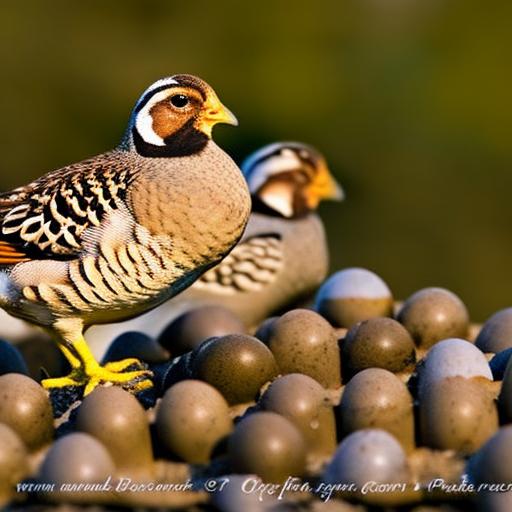Coturnix quail, also known as Japanese quail, are small game birds that are popular for their meat and eggs. They are native to East Asia and have been domesticated for thousands of years. Coturnix quail are known for their fast growth rate, high egg production, and ease of care, making them a popular choice for backyard poultry enthusiasts and small-scale farmers. There are several different breeds of Coturnix quail, each with its own unique characteristics and traits. In this article, we will explore the common and rare breeds of Coturnix quail, their characteristics, and the benefits of raising them. We will also provide tips for selecting and caring for Coturnix quail breeds.
Table of Contents
Key Takeaways
- Coturnix quail breeds are popular for their small size, fast growth, and high egg production.
- Common coturnix quail breeds include the Pharaoh, Italian, and Tuxedo varieties.
- Rare coturnix quail breeds such as the Tibetan, Golden, and White varieties are sought after by breeders and enthusiasts.
- Coturnix quail breeds are known for their docile nature, adaptability, and ability to thrive in various environments.
- Raising coturnix quail can provide a sustainable source of meat and eggs, as well as serve as a hobby or small business opportunity.
Common Coturnix Quail Breeds
The most common breed of Coturnix quail is the Pharaoh quail, also known as the standard or wild-type quail. This breed is known for its hardiness, adaptability, and high egg production. The Pharaoh quail has a brown and white speckled plumage, making it easy to identify. Another common breed is the Tuxedo quail, which is known for its striking black and white plumage. Tuxedo quail are popular for their ornamental value and are often kept for exhibition purposes. The British Range quail is another common breed that is prized for its large size and meat production. This breed has a distinctive brown and white plumage and is known for its calm and docile temperament. These common breeds of Coturnix quail are widely available and are popular choices for both meat and egg production.
In addition to the Pharaoh, Tuxedo, and British Range quail, there are several other common breeds of Coturnix quail, each with its own unique characteristics. The Golden Manchurian quail is known for its golden plumage and high egg production, while the Italian quail is prized for its large size and meat quality. The Texas A&M quail is a popular commercial breed that has been selectively bred for high egg production and fast growth rate. The Jumbo quail is another common breed that is known for its large size and meat production. These common breeds of Coturnix quail are popular choices for both backyard enthusiasts and commercial producers due to their desirable traits and characteristics.
Rare Coturnix Quail Breeds
While the Pharaoh, Tuxedo, British Range, Golden Manchurian, Italian, Texas A&M, and Jumbo quail are the most common breeds of Coturnix quail, there are also several rare and exotic breeds that are prized for their unique characteristics. The Tibetan quail is a rare breed that is known for its beautiful silver plumage and calm temperament. This breed is popular for exhibition purposes and is prized for its ornamental value. The Roux Dilute quail is another rare breed that has a unique dilute coloration, making it a sought-after choice for breeders and enthusiasts. The White Pearl quail is a rare albino variety that is prized for its striking white plumage and unique appearance.
In addition to the Tibetan, Roux Dilute, and White Pearl quail, there are several other rare breeds of Coturnix quail that are prized for their unique characteristics. The Rosetta quail is a rare variety with a beautiful rosette pattern on its plumage, making it a popular choice for exhibition and ornamental purposes. The Silver Tuxedo quail is another rare breed that has a striking silver and white plumage, making it a sought-after choice for breeders and enthusiasts. The Rare Coturnix Project has been working to develop new and unique color varieties of Coturnix quail, including rare colors such as lavender, blue, and cream. These rare breeds of Coturnix quail are prized for their unique characteristics and are popular choices for breeders and enthusiasts who are looking to add diversity to their flocks.
Characteristics of Coturnix Quail Breeds
Coturnix quail breeds vary in size, coloration, egg production, meat quality, and temperament. The Pharaoh quail is known for its hardiness, adaptability, and high egg production, making it a popular choice for both backyard enthusiasts and commercial producers. The Tuxedo quail is prized for its striking black and white plumage and is often kept for exhibition purposes due to its ornamental value. The British Range quail is known for its large size and meat production, as well as its calm and docile temperament.
In addition to these common breeds, there are several rare varieties of Coturnix quail that are prized for their unique characteristics. The Tibetan quail has beautiful silver plumage and a calm temperament, making it a popular choice for exhibition purposes. The Roux Dilute quail has a unique dilute coloration that sets it apart from other breeds, making it a sought-after choice for breeders and enthusiasts. The White Pearl quail is an albino variety with striking white plumage that is prized for its unique appearance.
Overall, Coturnix quail breeds exhibit a wide range of characteristics and traits that make them suitable for various purposes, including egg production, meat quality, exhibition, and ornamental value. Whether you are looking for hardy and productive breeds or rare and exotic varieties, there is a Coturnix quail breed to suit your specific needs and preferences.
Benefits of Raising Coturnix Quail
There are numerous benefits to raising Coturnix quail, regardless of whether you are a backyard enthusiast or a commercial producer. One of the main benefits of raising Coturnix quail is their fast growth rate and high egg production. Coturnix quail reach maturity quickly, with hens laying their first eggs at around 6-8 weeks of age. They are prolific layers, with some breeds laying up to 300 eggs per year. This makes them an excellent choice for those looking to produce their own eggs or start a small-scale egg business.
Another benefit of raising Coturnix quail is their small size and ease of care. Quail require minimal space compared to other poultry species, making them an ideal choice for those with limited land or backyard space. They are also relatively low maintenance, requiring simple housing, feed, water, and protection from predators. Their small size also makes them easier to handle and manage compared to larger poultry species.
In addition to their fast growth rate, high egg production, and ease of care, Coturnix quail are also valued for their meat quality. Quail meat is lean, flavorful, and nutritious, making it a popular choice for gourmet chefs and health-conscious consumers. Quail meat is also in high demand in many cultures around the world, making it a potentially lucrative enterprise for those looking to produce meat for sale.
Overall, the benefits of raising Coturnix quail include fast growth rate, high egg production, ease of care, small size, meat quality, and potential for profit. Whether you are looking to produce your own eggs and meat or start a small-scale poultry business, Coturnix quail offer numerous advantages that make them an attractive choice for poultry enthusiasts and producers.
Tips for Selecting and Caring for Coturnix Quail Breeds

When selecting Coturnix quail breeds, it is important to consider your specific goals and preferences. If you are primarily interested in egg production, you may want to choose breeds such as the Pharaoh or Texas A&M quail that are known for their high egg production. If you are interested in meat production, you may want to consider breeds such as the Jumbo or British Range quail that are prized for their large size and meat quality. If you are interested in exhibition or ornamental value, you may want to explore rare breeds such as the Tibetan or Roux Dilute quail that have unique coloration and plumage patterns.
Once you have selected your desired breeds of Coturnix quail, it is important to provide them with proper care and management. Quail require simple housing that provides protection from predators, adequate ventilation, and easy access to feed and water. They also require a balanced diet that includes commercial game bird feed supplemented with fresh greens, grains, and protein sources such as mealworms or crickets.
In addition to proper housing and nutrition, it is important to provide your quail with regular care and attention to ensure their health and well-being. This includes monitoring their behavior and appearance for signs of illness or distress, providing regular clean bedding and nesting materials, and maintaining a clean and sanitary living environment.
Overall, selecting and caring for Coturnix quail breeds requires careful consideration of your specific goals and preferences, as well as providing proper housing, nutrition, and care to ensure the health and well-being of your birds.
In conclusion, Coturnix quail breeds offer a wide range of characteristics and traits that make them suitable for various purposes including egg production, meat quality, exhibition, ornamental value, as well as being easy to care for due to their small size compared to other poultry species. Whether you are looking to produce your own eggs or meat or start a small-scale poultry business there is a Coturnix quail breed to suit your specific needs.
For those interested in learning more about Coturnix quail breeds or finding pictures of different varieties there are numerous resources available online including breeders’ websites forums social media groups dedicated to poultry keeping as well as books on the subject which can provide valuable information on selecting caring raising different breeds of Coturnix quails.
Additionally, attending poultry shows and fairs can also be a great way to see a variety of Coturnix quail breeds in person and speak with experienced breeders. These events often feature competitions for different breeds, allowing attendees to observe the unique characteristics and qualities of each type. By utilizing these resources, individuals can gain a deeper understanding of the diverse range of Coturnix quail breeds and make informed decisions when it comes to selecting and caring for their own flock.
If you’re interested in learning more about raising poultry, you might also enjoy reading about the compatibility of guinea fowl with chickens. Check out this insightful article on “Can Guinea Fowl Live with Chickens?” to discover whether these two bird species can coexist peacefully.
FAQs
What are Coturnix Quail?
Coturnix quail, also known as Japanese quail, are a species of Old World quail that are commonly raised for their meat and eggs. They are small, ground-dwelling birds that are known for their fast growth and high egg production.
What are the different breeds of Coturnix Quail?
There are several different breeds of Coturnix quail, including Pharaoh, Italian, Tuxedo, Texas A&M, and Jumbo. Each breed has its own unique characteristics, such as feather color and size.
Where can I find pictures of Coturnix Quail breeds?
You can find pictures of Coturnix quail breeds on various websites, including poultry breed directories, quail breeder websites, and online forums dedicated to quail keeping. Additionally, you can find pictures in books and publications about quail farming and raising.
What do Coturnix Quail look like?
Coturnix quail are small birds with mottled brown and white feathers. They have a plump body, short legs, and a distinctive striped pattern on their face. The different breeds of Coturnix quail may have variations in feather color and pattern.
Are there any specific characteristics to look for in Coturnix Quail breeds?
When selecting Coturnix quail breeds, it’s important to consider factors such as size, egg production, and temperament. Some breeds may be larger and better suited for meat production, while others may be smaller and more prolific egg layers. Additionally, some breeds may have specific color patterns that are desirable for breeding purposes.
Meet Walter, the feathered-friend fanatic of Florida! Nestled in the sunshine state, Walter struts through life with his feathered companions, clucking his way to happiness. With a coop that’s fancier than a five-star hotel, he’s the Don Juan of the chicken world. When he’s not teaching his hens to do the cha-cha, you’ll find him in a heated debate with his prized rooster, Sir Clucks-a-Lot. Walter’s poultry passion is no yolk; he’s the sunny-side-up guy you never knew you needed in your flock of friends!







